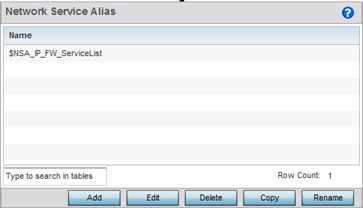Use a service alias to associate more than one IP address to a network interface, providing multiple connections to a network from a single IP node.
To define a service alias configuration for an IP firewall:

Use Copy to create a copy of the selected policy and modify it for further use. Use Rename to rename the selected policy.

Select Reset to revert to the last saved configuration. Select Exit to exit without creating a network service alias.
| Protocol | Specify the protocol for which the alias is created. Use the drop down to select the protocol from eigrp, gre, icmp, igmp, ip, vrrp, igp, ospf, tcp and udp. Select other if the protocol is not listed. When a protocol is selected, its protocol number is automatically selected. |
| Source Port (Low and High) | This field is relevant only if
the protocol is tcp or udp. Specify the source ports for this protocol entry. A range of ports can be specified. Select the Enter Ranges button next to the field to enter a lower and higher port range value. Up to eight (8) ranges can be specified. |
| Destination Port (Low and High) | This field is relevant only if
the protocol is tcp or udp. Specify the destination ports for this protocol entry. A range of ports can be specified. Select the Enter Ranges button next to the field to enter a lower and higher port range value. Up to eight (8) such ranges can be specified. |